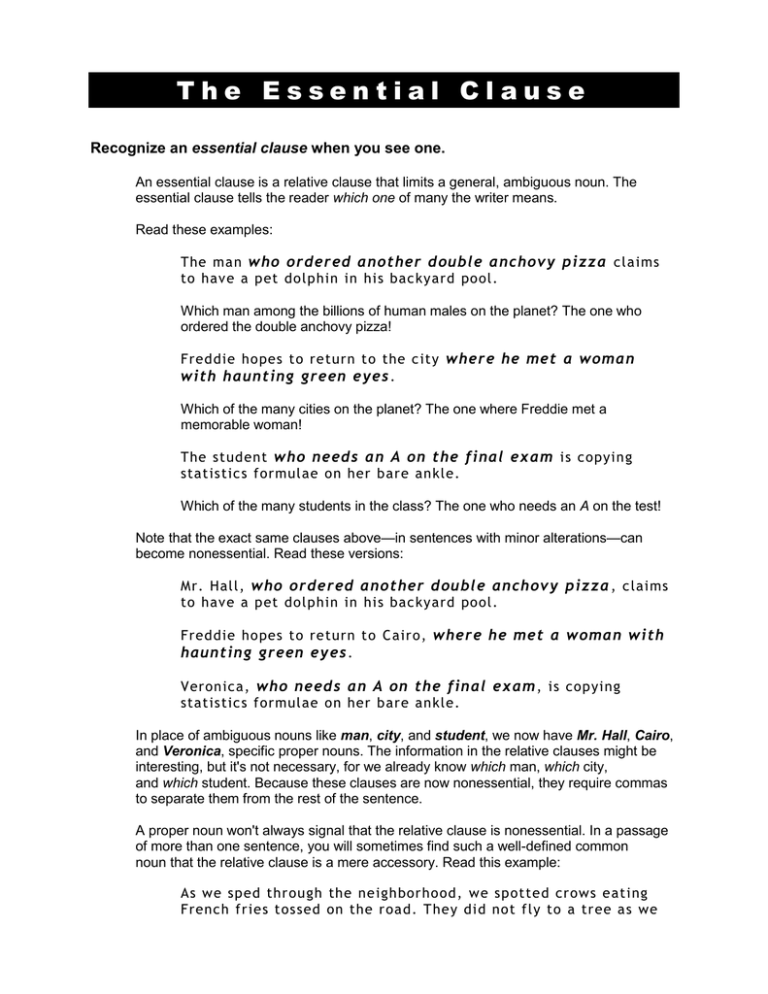
The Essential Clause
Recognize an essential clause when you see one.
An essential clause is a relative clause that limits a general, ambiguous noun. The
essential clause tells the reader which one of many the writer means.
Read these examples:
The man who ordered another double anchovy pizza claims
to have a pet dolphin in his bac kyard pool.
Which man among the billions of human males on the planet? The one who
ordered the double anchovy pizza!
Freddie hopes to return to the c ity where he met a woman
with haunting green eyes .
Which of the many cities on the planet? The one where Freddie met a
memorable woman!
The student who needs an A on the final exam is copying
statistic s formulae on her bare ankle.
Which of the many students in the class? The one who needs an A on the test!
Note that the exact same clauses above—in sentences with minor alterations—can
become nonessential. Read these versions:
Mr. Hall, who ordered another double anchovy pizza , c laims
to have a pet dolphin in his bac kyard pool.
Freddie hopes to return to Cairo, where he met a woman with
haunting green eyes .
Veronica, who needs an A on the final exam , is copying
statistic s formulae on her bare ankle.
In place of ambiguous nouns like man, city, and student, we now have Mr. Hall, Cairo,
and Veronica, specific proper nouns. The information in the relative clauses might be
interesting, but it's not necessary, for we already know which man, which city,
and which student. Because these clauses are now nonessential, they require commas
to separate them from the rest of the sentence.
A proper noun won't always signal that the relative clause is nonessential. In a passage
of more than one sentence, you will sometimes find such a well-defined common
noun that the relative clause is a mere accessory. Read this example:
As we sped through the neighborhood, we spotted crows eating
French fries tossed on the road. They did not fly to a tree as we
expec ted. The birds, which never showed fear of the vehicle ,
watched as we swerved around them.
The relative clause which never showed fear of the vehicle is nonessential since we
know which birds. Thus the clause requires commas.
Punctuate essential clauses correctly.
Since an essential clause provides necessary limits on the vague noun it describes, use
no punctuation to connect it.
The car that Madeline purchased from a newspaper
ad belches black smoke whenever she accelerates.
The rats are nesting in the closet where Grandma hides her
money .
The waiter who served the salad did not notice the caterpillar
nibbling a lettuce leaf.
When the clause becomes decorative rather than defining—or nonessential—you will
then need to separate it with commas:
The ancient Buick, which Madeline purchased from a
newspaper ad , belches black smoke whenever she accelerates.
The rats are nesting in the master bedroom closet, where
Grandma hides her money .
Javier, who served the salad , did not notice the caterpillar
nibbling a lettuce leaf.
©1997 - 2014 by Robin L. Simmons
All Rights Reserved.




